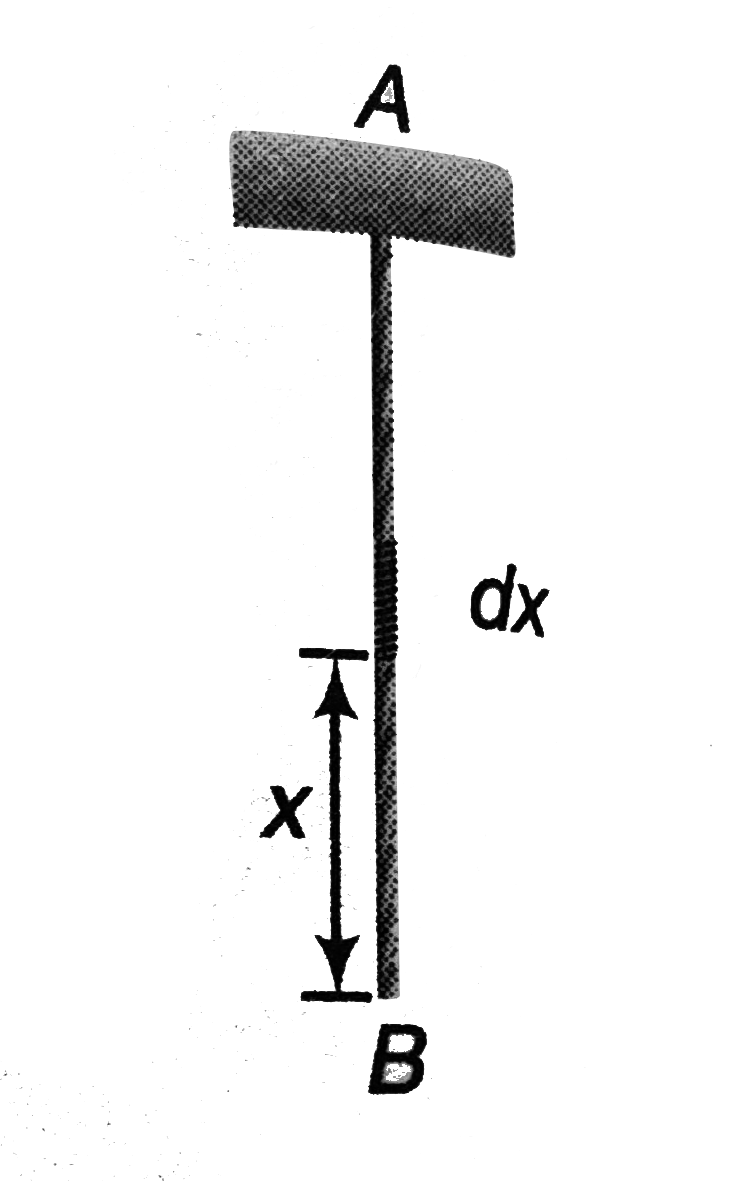A rod of steel is 5 m long and 3 cm diameter at a temperature of 20∘C. Find the free expansion of the rod when the temperature is raised to 65∘C. Determine the stress and pull exerted if (i) the ends do not yield and (ii) the ends yield by 0.12 cm. Take Y=2×105 MN/m2andα=12×10−6 per ∘C
Given Data : Diameter of the rod, d = 3 cm = 30 mm
Area of the rod, A=π4×302=706.86mm2 , Length of the rod, L=5m=5000 mm
Initial temperature, T1=202C , Final temperature T2=65∘C
∴ Rise in temperature, (T)=65−20=45∘C,Y=2×105N/mm2
Coefficient of linear expansion α=12×10−6/∘C
(i) When the ends do not yield
The stress is =α.T.Y=12×10−6×45×2×105=108N/mm2 (tensile)
Pull in the rod = Stress × Area =108×706.86=76340.88N=76.34kN.
(ii) When the ends yield by 0.12cm, δ=0.12cm=1.2mm
The stress when the ends yield is
Stress =(αTL−δ)L×Y=(12×10−6×45×5000−1.2)5000×2×105=60N/mm2
Pull in the rod = Stress × Area =60×706.86=42411.6=42.41kN
Topper's Solved these Questions
- EXPANSION OF SOLIDS BOOK - AAKASH SERIESCHAPTER - EXPANSION OF SOLIDS EXERCISE - Test your self
6 Videos
- EXPANSION OF SOLIDS BOOK - AAKASH SERIESCHAPTER - EXPANSION OF SOLIDS EXERCISE - Very Short Answer Type Questions
11 Videos
- EXPANSION OF LIQUIDS BOOK - AAKASH SERIESCHAPTER - EXPANSION OF LIQUIDS EXERCISE - QUESTIONS FOR DESCRIPTIVE ANSWERS
4 Videos
- FLUID MECHANICSBOOK - AAKASH SERIESCHAPTER - FLUID MECHANICSEXERCISE - Questions for Descriptive Answers
14 Videos
Similar Questions
A rod of length 2 m is at a temperature of 20∘ C. find the free expansion of the rod, if the temperature is increased to 50∘C, then find stress produced when the rod is (i) fully prevented to expand, (ii) permitted to expand by 0.4mm. Y=2×1011N/m2,α=15×10−6/∘C.
View SolutionA rod of length 2 m is at a temperature of 20∘ C. find the free expansion of the rod, if the temperature is increased to 50∘C, then find stress produced when the rod is (i) fully prevented to expand, (ii) permitted to expand by 0.4mm. Y=2×1011N/m2,α=15×10−6/∘C.
View Solution
Knowledge Check
A rod of steel is 5m long and 3cm diameter at a tempearatyre if 20∘C. Find the free expansion of the rod when the temperature us raused ti 65∘C. Find the respective pulls exerted if (i) the ends do not yield and (ii) the ends yield by 0.12cm.Y=2×105MN/m2 and α=12×106 per ^(∘)C
A0.27cm,42.41KN,76.34KNB0.27cm,76.30KN,42.39KNC0.27cm,38.63KN,78.23KND0.27cm,78.23KN,38.63KNA rod of length 2 m is at a temperature of 20∘ C. find the free expansion of the rod, if the temperature is increased to 50∘C, then find stress produced when the rod is (i) fully prevented to expand, (ii) permitted to expand by 0.4mm. Y=2×1011N/m2,α=15×10−6/∘C.
A6×107N/m2B9×105N/m2C9×107N/m2D6×105N/m2The temperature gradient in a rod of 0.5 m long is 80∘C/m. If the temperature of hotter end of the rod is 30∘C, then the temperature of the colder end is
A40∘CB−10∘CC10∘CD0∘C
A steel rod of length 6.0m and diameter 20mm is fixed between two rigid supports. Determine the stress in the rod, when the temperature increases by 80∘C if
(a) the ends do not yield (b) the ends yield by 1mm
Take Y=2.0×106kg/cm2andα=12×10−6per∘C.

View SolutionA steel rod of length 6.0m and diameter 20mm is fixed between two rigid supports . Determine the stress in the rod, when the temperature increases by 80∘C if
(a)the ends do not yield (b) the ends yield by 1mm
Take Y=2.0×106kg/cm2and α=12×10−6per∘C.

View SolutionA steel rod of length 6.0 m and diameter 20 mm is fixed between two rigid supports. Determine the stress in the rod, when the temperature increased by 80∘C if ends do not yield. Take Y=2.0×105kg/cm2andα=12×10−6per .∘C.
View SolutionAt 40∘C, a brass rod has a length 50 cm and a diameter 3.0 mm. it is joined to a steel rod of the same length and diameter at the same temperature. What is the change in the length of the composite rod when it is heated to 240∘C? The coefficient of liear expansion of brass and steel are 2.0×10−5.∘C−1 and 1.2×10−5.∘C−1 respectively:
View SolutionA metal rod (Y+2×1012dyne(cm)−2) of coefficient of linear expansion 1.6×10−5 per .=C has its temperature raised by 20∘C. The linear compressive stress to prevent the expansion of the rod is
View Solution
